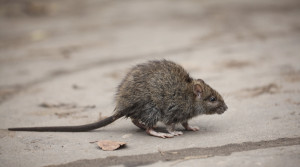Norway or Brown Rat
There are many wildlife pests that homeowners have issues with, but rats are often one of the most unpleasant of all. There are two types of rats that are commonly an issue for homeowners, these are the Norway Rat and the Roof Rat. In this article we will be focusing on the Norway Rat.
The Norway rat, more commonly known as the Brown rat, is the largest rat species in North America and Europe. The species originated in China, and spread to every continent with the exception of Antarctica. The rat is a dark brown or grey, and is around 8 to 10 inches long with a tail of about the same length. The Norway Rat is most famous for being the carrier of the fleas that brought the Black Death to Europe during the Middle Ages. Shipping allowed the rats to spread to every continent via boats and other transportation. The rats will eat almost any form of food. Interestingly, Norway rats living on the island of Norderoog, which is located in the North Sea, prey on sparrows and ducks in a predatory fashion. These common rats are extremely adaptable and can live in many different places.
The rats commonly live in burrows that they dig. They will hide in these burrows during the day and leave them to seek food and water. Typically these burrows will be large and house a community of rats, and they will live within a social hierarchy similar to dogs. These burrows serve as a defense against predators and a safe nesting sight that is protected from the weather. The rats often store food inside of these burrows as well and will immediately run to them when threatened.
Norway rats can breed any time of the year, and will produce between 8 and 20 offspring per litter. The reproduction is quick and therefore allows a rat infestation to grow quickly. In the wild, rats typically live only one year and females will have between 3 and 12 litters of offspring in their lifetime. Often this allows small burrows to grow into large populations of the rats. The rats will seek food and water and this can often lead them into homes.
Rats are damaging house guests, and will contaminate food, damage buildings with tunneling and gnawing, and can damage wires and pipes. Rats can gnaw holes into doors, windows, and other openings, as well as damaging insulation. When looking for signs of potential infestation, look for evidence of gnawing around the house. Droppings are another sign of infestation, and often squeaking and gnawing can be heard late at night. Typically, the rats will form nesting sites either inside of crawl spaces and attics, or they can be found outside in burrows. These outdoor burrows are typically found close to the sides of foundations, and can be very large and interconnected. This can potentially cause erosion and remove support from under parts of structures if the burrows grow to be too large. The rats are most active during then night, and an infestation can quickly grow to difficult to deal with.
Like all rats, Norway Rats are extremely suspicious of environmental change, and this makes trapping them difficult. Any traps that are placed with bait must be left for several days before the rats will trust them enough to get close. While poison can be an effective measurement, the most useful way to remove rats is the use of baited traps. The advantage of traps is that they allow the homeowner to know when a rat has been trapped and approximate the location of the nest. For small infestations, a few traps can typically resolve the issue. However large infestations usually require professional experience to deal with. It is important to remember that Norway rats often carry disease and bacteria and as a result should be handled carefully. Once a rat infestation is removed, it is important to find where the rats entered into the house and make sure to patch up any holes or entrances that are not protected. Any opening of around 1/2 inch or larger is big enough for a rat to fit through. It is also helpful to make sure no open water sources exist in the house for the rats such as leaky sprinklers or pet food and water bowls.
Norway rats can be a huge problem for homeowners, but with the right protection and extermination methods, they can be dealt with. If you think you may have a Norway rat infestation, our technicians have years of experience dealing with rat infestation. We can inspect any home to determine if an infestation or burrow is nearby, and, if necessary, our guys are trained to deal with any rats with the utmost safety and efficiency. If you need help with rats, or any other pest, call us today at 770-479-1598!
By: Tim

